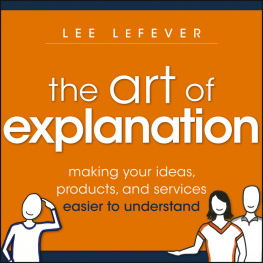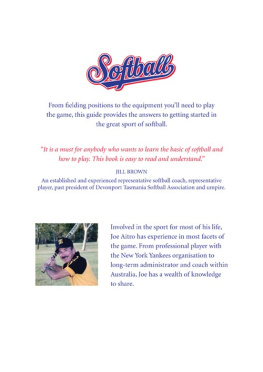
Cover image: Courtesy of Lee LeFever
Cover design: C. Wallace
This book is printed on acid-free paper.
Copyright 2013 by Lee LeFever. All rights reserved.
Published by John Wiley & Sons, Inc., Hoboken, New Jersey.
Published simultaneously in Canada.
No part of this publication may be reproduced, stored in a retrieval system, or transmitted in any form or by any means, electronic, mechanical, photocopying, recording, scanning, or otherwise, except as permitted under Section 107 or 108 of the 1976 United States Copyright Act, without either the prior written permission of the Publisher, or authorization through payment of the appropriate per-copy fee to the Copyright Clearance Center, Inc., 222 Rosewood Drive, Danvers, MA 01923, (978) 750-8400, fax (978) 646-8600, or on the web at www.copyright.com. Requests to the Publisher for permission should be addressed to the Permissions Department, John Wiley & Sons, Inc., 111 River Street, Hoboken, NJ 07030, (201) 748-6011, fax (201) 748-6008, or online at http://www.wiley.com/go/permissions.
Limit of Liability/Disclaimer of Warranty: While the publisher and author have used their best efforts in preparing this book, they make no representations or warranties with respect to the accuracy or completeness of the contents of this book and specifically disclaim any implied warranties of merchantability or fitness for a particular purpose. No warranty may be created or extended by sales representatives or written sales materials. The advice and strategies contained herein may not be suitable for your situation. You should consult with a professional where appropriate. Neither the publisher nor author shall be liable for any loss of profit or any other commercial damages, including but not limited to special, incidental, consequential, or other damages.
For general information on our other products and services or for technical support, please contact our Customer Care Department within the United States at (800) 762-2974, outside the United States at (317) 572-3993 or fax (317) 572-4002.
Wiley publishes in a variety of print and electronic formats and by print-on-demand. Some material included with standard print versions of this book may not be included in e-books or in print-on-demand. If this book refers to media such as a CD or DVD that is not included in the version you purchased, you may download this material at http://booksupport.wiley.com. For more information about Wiley products, visit www.wiley.com.
Library of Congress Cataloging-in-Publication Data:
LeFever, Lee, 1973
Art of explanation : making your ideas, products, and services easier tounderstand / Lee LeFever.
p. cm.
Includes bibliographical references and index.
ISBN 978-1-118-37458-0 (pbk.); ISBN 978-1-118-41731-7 (ebk); ISBN 978-1-118-42069-0 (ebk); ISBN 978-1-118-43429-1 (ebk)
1.Interpersonal communication. 2.Comprehension. 3.Explanation
(Linguistics) 4.Business communication.I. Title.
BF637.C45L45 2013
302.2dc23
2012022700
For Sachi
Preface
Chances are that you explained something recentlywhy dinner tastes the way it does, why you were late for a meeting, what an article means to your company. We explain so many different things so frequently that we take the art of explanation for granted. This is a tragedy because a great explanation can make our ideas come to life, invite people to care and be motivated to learn more. However, we lose the opportunity to do this unless we recognize that explanation is an essential skill we can learn and master.
Imagine the potential that better explanations have for both your personal and professional interactions. What if your boss, accountant, team member, or mother could suddenly explain ideas in a more understandable way? What if they could put themselves in your shoes and make their ideas clear in a way that acknowledged your perspective? That is the goal of this book. I want to help you and the people around you become better explainers because we desperately need better explanations. Although this book is primarily aimed at professionals, it is meant for everyone, and intended to make the world a more understandable place in which to live and work.
The Art of Explanation is built on my years of experience in creating explanations for organizations and educators. My company, Common Craft, is known around the world for making complex ideas easy to understand in the the form of short videos. Through projects with companies such as Google, LEGO, Intel, and Ford Motor Company and the creation of our own library of video explanations, we have been students of explanation for many years. We have experimented and studied the explanation process and seen what is possible. Our videos have been viewed more than 50 million times online, and no other brand is better known for explanations (http://commoncraft.com/videos).
This book, however, is not a series of case studies and exercises or an academic exploration of the science of explanation. More than anything, it is a manifesto based on our experiences as professional explainers. We believe deeply in the power of explanation and see this book as an invitation to recognize that power by looking at explanation from a new perspective. When you do, you will see that it represents an unexplored part of your communications, a skill you can understand, practice, and improve.
The various ideas, approaches, and models I provide in these pages are secondary to a simple, higher-level goal: to make explanation a priority. This means thinking about how you explain ideas and how you can put explanations to work to accomplish your goals. It requires that you use explanation as a strategy in problem solving. You must also introduce others to the idea that explanations can create positive change.
It is this overarching perspective that matters because, as the title suggests, explanation is an art. Although there are tools, tactics and ideas that help, we all explain differently, and that is the beauty of it. Explanations do not follow a set of specific steps and rules. They are effective because of the perspective and intent of the explainer. Looking at a problem through the lens of explanation can reveal challenges that may not have been visible before. When the intent is to create an explanation to address these challenges, we all have the potential to use the ideas in this book to build explanations in our own way.
Many of these ideas and concepts are introduced via short, fictional stories of individuals who discover the challenges and potential of explanation in various situations. These stories reflect what we believe is one of the most powerful aspects of explanation: presenting ideas from a person's or group's perspective. They also serve as an antidote to endless bullet points and lists, and provide you with an entertaining way to absorb and remember ideas.
Multiple examples of our own explanations are included, all of which have corresponding video scripts or links to videos on our website. These scripts give concrete examples of our approach to specific explanation problems that have a record of success and are a model for your own explanations.
The book is organized into three parts that align with the basic process of creating explanationsPlan, Package, and Present:
Part 1: Plan
This part of the book is meant to build a solid foundation for the idea of explanation. To create successful explanations, we need to answer such basic questions as:
Next page














